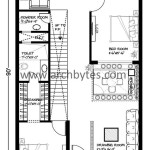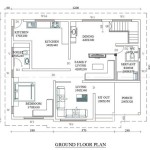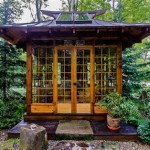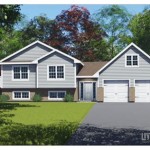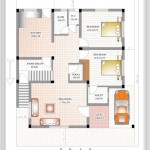1910 Craftsman House Plans: A Glimpse into American Architectural History
The early 20th century witnessed the flourishing of the Craftsman architectural style, a movement that championed simplicity, functionality, and handcrafted details. Originating as a reaction against the excesses of Victorian-era design and the perceived dehumanizing effects of industrialization, the Craftsman style, also known as the Arts and Crafts movement in architecture, emphasized the beauty of natural materials and the skill of the artisan. 1910 stands as a pivotal year in this architectural trend, offering a wealth of house plans that embody the core principles of the Craftsman aesthetic. Examining these plans provides valuable insights into the social, cultural, and technological contexts that shaped American housing during this period.
Craftsman house plans of 1910 reflect a desire for homes that were both aesthetically pleasing and practical for everyday living. These plans were not merely blueprints; they were often accompanied by detailed descriptions of materials, techniques, and even suggested interior decorating schemes. This comprehensive approach allowed homeowners to fully embrace the Craftsman philosophy, creating homes that were harmonious, comfortable, and reflective of their personal values.
Key Features of 1910 Craftsman House Plans
Several defining characteristics distinguish 1910 Craftsman house plans from other architectural styles. These features worked together to create homes that were visually appealing, structurally sound, and deeply connected to their natural surroundings.
Low-Pitched Roofs and Wide Eaves: One of the most recognizable elements of a Craftsman house is its low-pitched roof, often with a broad overhang and exposed rafters. This design feature provides shade and protection from the elements, while also adding a sense of groundedness to the structure. The wide eaves often extended far beyond the walls, creating deep shadows and enhancing the visual interest of the roofline. Gable roofs were common, although hipped roofs were also occasionally found. The emphasis was on simplicity and functionality, with the roof design contributing to the overall sense of shelter and stability.
The extended eaves also served a practical purpose by deflecting rainwater away from the foundation, helping to prevent moisture damage and prolong the life of the structure. The exposed rafters, often left unpainted or stained to highlight the natural grain of the wood, were a testament to the Craftsman emphasis on honest construction and the beauty of natural materials. This attention to detail extended to all aspects of the roof design, reflecting the Craftsman belief that every element of the house should be both functional and aesthetically pleasing.
Emphasis on Natural Materials: Craftsman houses of 1910 frequently highlighted the use of natural materials, both inside and out. Wood was the primary building material, often used for siding, trim, flooring, and interior paneling. Stone, brick, and stucco were also commonly incorporated, adding texture and visual variety to the exterior. The emphasis was on showcasing the inherent beauty of these materials, rather than concealing them behind layers of paint or ornamentation. Wood was often stained to reveal its natural grain, while stone and brick were left exposed to highlight their unique textures and colors.
Interior spaces also reflected this commitment to natural materials. Wood trim, including baseboards, door frames, and window casings, was a common feature, adding warmth and character to the rooms. Hardwood floors were typically used throughout the house, providing a durable and aesthetically pleasing surface. Fireplaces, often constructed of brick or stone, served as focal points in the living room, providing both warmth and a visual connection to the natural world. The use of natural materials helped to create homes that were both beautiful and sustainable, reflecting the Craftsman movement's concern for environmental responsibility.
Open Floor Plans and Built-in Features: While not always as open as contemporary designs, 1910 Craftsman house plans often featured a more open floor plan than their Victorian predecessors. Living spaces were designed to flow seamlessly together, creating a sense of spaciousness and facilitating social interaction. Built-in features, such as bookcases, cabinets, and window seats, were also common, maximizing space and providing convenient storage solutions. These built-ins were not merely functional; they were also carefully designed to complement the overall aesthetic of the house, adding to its charm and character.
The open floor plans allowed for better circulation of light and air, creating more comfortable and inviting living spaces. The built-in features helped to reduce clutter and create a sense of order and organization. These design elements reflected the Craftsman movement's emphasis on practicality and functionality, as well as its commitment to creating homes that were both beautiful and livable. The integration of these elements demonstrated a thoughtful approach to design, considering the needs and preferences of the homeowners.
The Influence of Gustav Stickley and The Craftsman Magazine
The popularization of the Craftsman style can be largely attributed to Gustav Stickley, a furniture designer and publisher who became a leading voice for the Arts and Crafts movement in America. His magazine, *The Craftsman*, which was published from 1901 to 1916, played a crucial role in disseminating the Craftsman aesthetic and promoting its values. The magazine featured articles on architecture, interior design, and craftsmanship, as well as detailed house plans that homeowners could order directly. These plans were carefully designed to embody the principles of the Craftsman movement, emphasizing simplicity, functionality, and the use of natural materials.
*The Craftsman* magazine not only provided practical guidance for building and decorating Craftsman homes, but also articulated the philosophical underpinnings of the movement. Stickley argued that homes should be designed to reflect the values of honesty, integrity, and craftsmanship. He believed that these values were essential for creating a more just and equitable society. The magazine also promoted the idea that homes should be designed to be harmonious with their natural surroundings, encouraging homeowners to incorporate elements of nature into their designs. The influence of *The Craftsman* magazine was profound, shaping the tastes and preferences of a generation of Americans and contributing to the widespread adoption of the Craftsman style.
The house plans featured in *The Craftsman* magazine were typically small to medium in size, reflecting the desire for modest and affordable homes. They often featured open floor plans, built-in features, and an emphasis on natural light. The exterior designs were characterized by low-pitched roofs, wide eaves, and the use of natural materials such as wood, stone, and brick. These plans were not merely blueprints; they were carefully crafted to embody the principles of the Craftsman movement and to provide homeowners with a clear vision for creating a beautiful and functional home.
Materials and Construction Techniques of 1910
Understanding the materials and construction techniques employed in 1910 Craftsman houses provides further insight into their enduring appeal and structural integrity. The choice of materials and the methods used to assemble them were integral to the Craftsman philosophy, emphasizing durability, longevity, and the inherent beauty of the building process.
Wood Framing and Siding: The primary structural component of most 1910 Craftsman houses was wood framing, typically using dimension lumber such as 2x4s for studs and 2x8s or larger for joists and rafters. This framing provided a strong and stable skeleton for the house, capable of withstanding the stresses of weather and time. The exterior walls were often clad in wood siding, such as clapboard, shingle, or board-and-batten. These siding materials provided weather protection and added to the visual appeal of the house. The choice of siding material often depended on the local climate and the availability of resources. In some areas, cedar shingles were a popular choice, while in others, clapboard or board-and-batten siding were more common.
The wood used for framing and siding was typically sourced from local forests, reflecting the Craftsman movement's emphasis on sustainability and regionalism. The wood was often milled using traditional techniques, preserving its natural grain and character. The use of wood framing and siding not only provided a strong and durable structure, but also contributed to the warmth and inviting atmosphere of the house.
Foundation and Masonry: The foundation of a 1910 Craftsman house was typically constructed of concrete, stone, or brick. These materials provided a solid and stable base for the house, protecting it from moisture and preventing settling. The foundation was often built with a rubble trench, a layer of gravel that helped to drain water away from the foundation walls. Masonry was also frequently used for chimneys, fireplaces, and porch supports, adding to the structural integrity and visual appeal of the house. The use of masonry materials provided a sense of permanence and stability, reinforcing the Craftsman emphasis on durability and longevity.
The construction of the foundation and masonry elements was typically done by skilled craftsmen, who took pride in their work and paid close attention to detail. The mortar used to bind the stones or bricks together was carefully mixed and applied, ensuring a strong and watertight bond. The use of high-quality materials and skilled craftsmanship contributed to the enduring quality of these houses, allowing them to withstand the test of time.
Interior Finishes and Detailing: Interior finishes in 1910 Craftsman houses were characterized by simplicity and functionality. Walls were typically plastered and painted in muted colors, such as cream, beige, or light green. Wood trim, including baseboards, door frames, and window casings, was a common feature, adding warmth and character to the rooms. Hardwood floors were typically used throughout the house, providing a durable and aesthetically pleasing surface. Fireplaces, often constructed of brick or stone, served as focal points in the living room, providing both warmth and a visual connection to the natural world. The attention to detail in the interior finishes reflected the Craftsman movement's emphasis on quality and craftsmanship. Every element of the interior was carefully considered, from the choice of paint colors to the design of the trim, to create a harmonious and inviting living space.

Standard Little Bungalow Henry Wilson 1910 Small House Plan Vintage Plans

Charming 1910 Bungalow Design

Example Of A Craftsman Bungalow Very American Style Home Many Built In 1910 1930 All C Bungalows Vintage House Plans Styles

Versatile Bungalow Plan The Book 1910 Inglenook Vintage House Plans Craftsman

House Floor Plans 1910s 1930s Bungalow Craftsman

Wrapped Porch Battered Columns Bungalow House Plan 1910 Wilson Vintage Plans

1910 The Bungalow Book Wilson Design No 158 Modest One Story House Vintage Plans Sims

9 Vintage Cottage Home Plans From 1910 Americana

1910 Early Eclectic English Tudor Design No 540 Story And A Half Bungalow Book

Bungalow 1910 To 1940 City Planning


